Attached files
| file | filename |
|---|---|
| 8-K - 8-K - DYCOM INDUSTRIES INC | dyfy2019q18k-investorprese.htm |

Exhibit 99.1 Investor Presentation May & June 2018

Forward Looking Statements, Non‐GAAP Financial Measures and Other Information This presentation contains “forward‐looking statements”. Other than statements of historical facts, all statements contained in this presentation, including statements regarding the Company’s future financial position, future revenue, prospects, plans and objectives of management, are forward‐looking statements. Words such as “outlook,” “believe,” “expect,” “anticipate,” “estimate,” “intend,” “should,” “could,” “project,” and similar expressions, as well as statements in future tense, identify forward‐lookingstatements.Youshouldnotconsiderforward‐looking statements as a guarantee of future performance or results. Forward‐looking statements are based on information available at the time those statements are made and/or management’s good faith belief at that time with respect to future events. Such statements are subject to risks and uncertainties that could cause actual performance or results to differ materially from those expressed in or suggested by the forward‐looking statements. Important factors, assumptions, uncertainties, and risks that could cause such differences are discussed in our Transition Report on Form 10‐K filed with the Securities and Exchange Commission (“SEC”) on March 2, 2018, and other filings with the SEC. The forward‐looking statements in this presentation are expressly qualified in their entirety by this cautionary statement. The Company undertakes no obligation to update these forward‐looking statements to reflect new information, or events or circumstances arising after such date. This presentation includes certain “Non‐GAAP” financial measures as defined by Regulation G of the SEC. As required by the SEC, we have provided a reconciliation of those measures to the most directly comparable GAAP measures on the Regulation G slides included as slides 29 through 36 of this presentation. Non‐GAAPfinancialmeasuresshouldbeconsideredinadditionto, but not as a substitute for, our reported GAAP results. 2

Dycom Overview Leading supplier of specialty contracting services to telecommunication providers Nationwide footprint Operates in all 50 states, Washington, D.C. and in Canada Over 40 operating subsidiaries and over 14,600 employees Strong revenue base, customer relationships and profitable results Contract revenues of $2.98 billion for the trailing four quarters ended January 27, 2018 Non‐GAAP Adjusted EBITDA of $383.5 million, or 12.9% of revenues for the trailing four quarters ended January 27, 2018 Non‐GAAP Adjusted Diluted EPS of $3.88 for the trailing four quarters ended January 27, 2018 Solid financial profile Liquidity of $459.3 million at April 28, 2018, consisting of cash and availability under our credit facility No outstanding revolver borrowings at the end of Q1‐19 See “Regulation G Disclosure” slides 29‐36 for a reconciliation of GAAP to Non‐GAAP financial measures. 3

Telecommunications Industry Overview Telecommunications networks fundamental to economic progress Fiber is the foundation globally for wireline and wireless networks Consumer demand for bandwidth driving fiber deployments by telecom providers With a low percentage of total broadband connections provisioned by fiber in U.S., significant opportunities for sustained growth Source: Organisation for Economic Co‐operation and Development (OECD), Broadband Portal (June 2017) 4
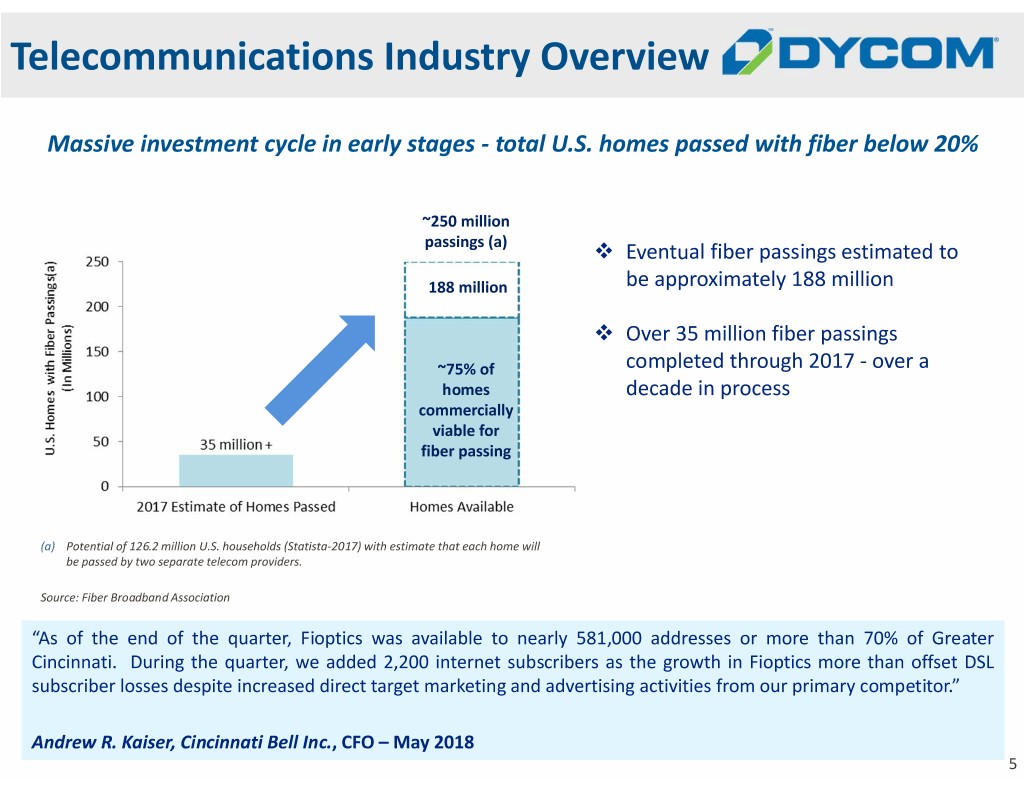
Telecommunications Industry Overview Massive investment cycle in early stages ‐ total U.S. homes passed with fiber below 20% ~250 million passings (a) Eventual fiber passings estimated to 188 million be approximately 188 million Over 35 million fiber passings ~75% of completed through 2017 ‐ over a homes decade in process commercially viable for fiber passing (a) Potential of 126.2 million U.S. households (Statista‐2017) with estimate that each home will be passed by two separate telecom providers. Source: Fiber Broadband Association “As of the end of the quarter, Fioptics was available to nearly 581,000 addresses or more than 70% of Greater Cincinnati. During the quarter, we added 2,200 internet subscribers as the growth in Fioptics more than offset DSL subscriber losses despite increased direct target marketing and advertising activities from our primary competitor.” Andrew R. Kaiser, Cincinnati Bell Inc., CFO – May 2018 5

Strong Secular Trend North America Internet Protocol Traffic vs. GDP Growth Strong and stable growth in IP traffic even in times of GDP decline “IP traffic in North America will reach 85 EB per month by 2021, at a CAGR of 20 percent. Monthly Internet traffic in North America will generate 11 billion DVDs’ worth of traffic, or 44.7 EB per month.” “Business IP traffic will grow fastest in North America. Business IP traffic in North America will grow at a CAGR of 23 percent, a faster pace than the global average of 21 percent.“ Cisco VNI: Forecast and Methodology, 2016–2021 (June 2017) Sources: U.S. Telecom, The Broadband Association; Cisco Visual Networking Index; U.S. National Bureau of Economic Analysis 6

Industry Drivers Firm and strengthening end market opportunities Fiber deployments in contemplation of emerging wireless technologies have begun in many regions of the country. A significant number of new project initiations are occuring. Wireless construction activity in support of expanded coverage and capacity is poised to accelerate. Telephone companies deploying FTTH to enable video offerings and 1 gigabit connections. This activity has begun to increase. Cable operators continuing to deploy fiber to small and medium businesses and enterprises. Fiber deep deployments to expand capacity, new build opportunities and overall cable capital expenditures are increasing. Customers are consolidating supply chains creating opportunities for market share growth and increasing the long‐term value of our maintenance business. We are increasingly providing integrated planning, engineering and design, procurement and construction and maintenance services for our customers. Encouraged that industry participants are committed to multi‐year capital spending initiatives; these initiatives are increasing in numbers across multiple customers 7

Key Driver: High Bandwidth Deployments AT&T Verizon Sources: AT&T Press Releases and transcripts. Sources: Verizon Nov‐17 Analyst Presentation Telephone companies are deploying fiber to the home and fiber to the node technologies to enable video offerings and 1 gigabit connections Data transmission speeds dramatically increasing Key customer committed to passing millions of new locations with fiber “We're on track to surpass our commitment as part of the DIRECTV deal to “We are pre‐positioning our networks as fiber infrastructure, spectrum build fiber to 12.5 million customer locations. We now reached more than 8 resources, and the rollout of our Verizon Intelligent Edge Network architecture. million locations with fiber and plan to hit 10 million by the end of this year. We are excited about the initial commercial launch of our 5G residential This is in addition to the 8 million business locations that we pass today within broadband offering later this year as the first slice of a multi‐use asset. We are 1,000 feet with fiber. These 16 million locations and the more than 1 million on the forefront of innovation that will drive the full suite of services and use route miles of fiber in our overall network are the backbone of our network and cases that will be delivered by 5G technologies.” our move to 5G. With FirstNet, 5G and fiber build, our network development has never moved at a faster pace.” John J. Stephens, AT&T, Inc , Senior Executive VP and CFO ‐ April 2018 Matthew D. Ellis, Verizon Communications, Inc., CFO & EVP ‐ April 2018 8

Key Driver: Wireless Network Upgrades Growth in Number of Cell Sites¹ 500,000 Wireless carriers are increasing 4G capacity and 450,000 augmenting 4G with new 5G technologies creating 400,000 growth opportunities in the near to intermediate 350,000 term 300,000 Cities 250,000 Carriers enhancing coverage and capacity by Cell 200,000 increasing the number of small cells. 300,000 small US 150,000 cell deployments expected over next 3‐4 years 100,000 50,000 Emerging wireless technologies driving significant 0 wireline deployments 2000 2001 2002 2003 2004 2005 2006 2007 2008 2009 2010 2011 2012 2013 2014 2015 2016 Wireline deployments necessary to facilitate Estimates Estimates expected decades long deployment of fully 2020 2025 converged wireless/wireline networks that * Compound Annual Growth Rate (CAGR) will enable high bandwidth low latency applications “Mobile connectivity has become essential for many network users. Most people already consider mobile voice service a necessity, and mobile voice, data, and video services are fast becoming an integral part of consumers and business users’ lives. Used extensively by consumer as well as enterprise segments, with impressive uptakes in both developed and emerging markets, mobility has proved to be transformational. The number of mobile subscribers has grown rapidly, and bandwidth demand for data and video content continues to increase. Mobile M2M connections represent the fastest growing device/connection category in our forecast. The next 5 years are projected to provide unabated mobile video adoption. Backhaul capacity and efficiency must increase so mobile broadband, data access, and video services can effectively support consumer usage trends and keep mobile infrastructure costs in check.” Cisco VNI Mobile, 2017 1 Source: Industry publications and accenturestrategy report (March 12, 2018) 9

Key Driver: Fiber to Businesses Revenue earned by Comcast and Charter from Business Services totaled $12.1 Billion1 of an Addressable Market of $70 billion 2 Sources: Comcast and Charter Press Releases and transcripts “Moving on to business services, which continues to be a top driver of our overall Cable results, we delivered another strong quarter of double‐digit growth, with revenue increasing 11.9% to $1.7 billion during the quarter, primarily driven by customer growth. We added 29,000 business customer relationships in the quarter and grew revenue per business customer relationship by 5%. These results are driven by connectivity, as the rollout of DOCSIS 3.1 has enabled us to offer gigabit speeds to small businesses and our investment to push fiber deeper in our network helps us continue to increase the number of mid‐size customers. All business services segments, small, medium‐sized, and now enterprise, are focused on connectivity and have substantial room for future growth.” Michael J. Cavanagh, CFO & Senior EVP, Comcast –April 2018 1 For the Trailing Twelve Months (“TTM”) ended March 31, 2018 2 Calculated as the combination of the estimated addressable market given by Charter ($20Bn) and Time Warner Cable ($10Bn) in their respective earnings transcripts prior to their May 2016 merger. 10

Intensely Focused on Telecommunications Market Services Crucial to Customers’ Success Contract revenues of $731.4 million for Q1‐19 Telecommunications Outside Plant & Equipment Installation Wireless Premise Equipment Installation Engineering Underground Facility Locating Electric and Gas Utilities Underground and Other Facility Locating Dycom is well‐positioned to benefit from future growth opportunities 11

Local Credibility, National Capability Dycom’s Nationwide Presence Subsidiaries 12
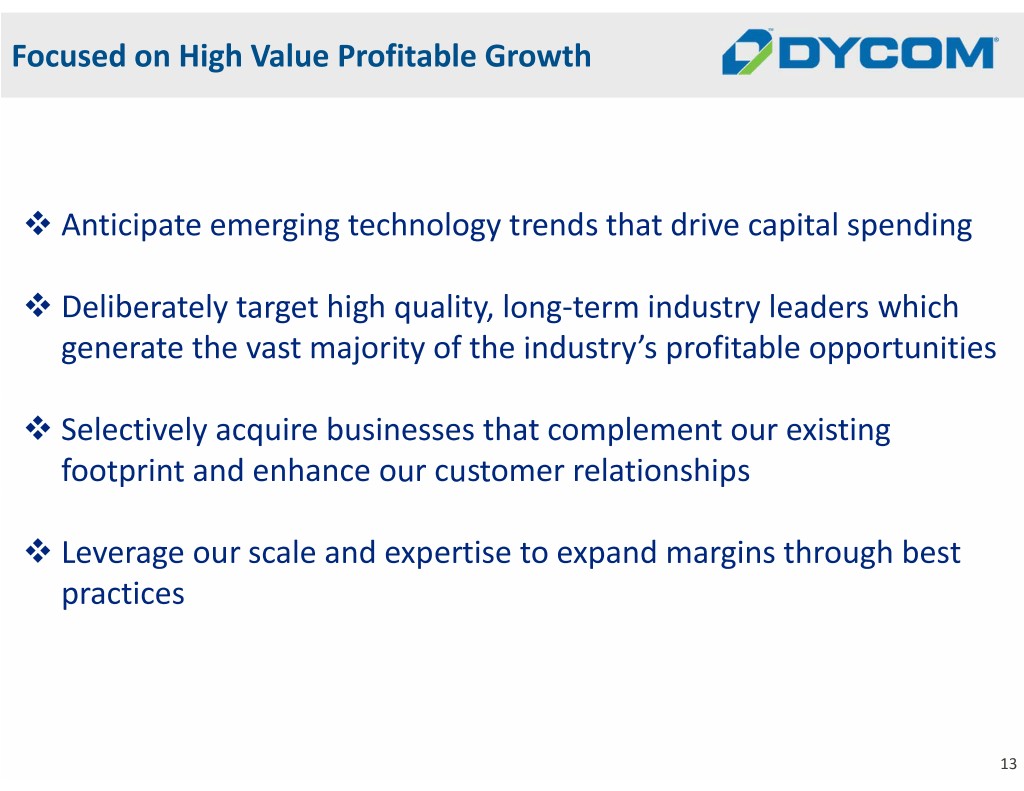
Focused on High Value Profitable Growth Anticipate emerging technology trends that drive capital spending Deliberately target high quality, long‐term industry leaders which generate the vast majority of the industry’s profitable opportunities Selectively acquire businesses that complement our existing footprint and enhance our customer relationships Leverage our scale and expertise to expand margins through best practices 13

Well Established Customers Top Customers Customer Revenue Breakdown Q1‐19 Dycom has established relationships with: Telephone companies Wireless carriers Cable multiple system operators Electric utilities and others Blue‐chip, investment grade customers comprise a substantial portion of revenue 14
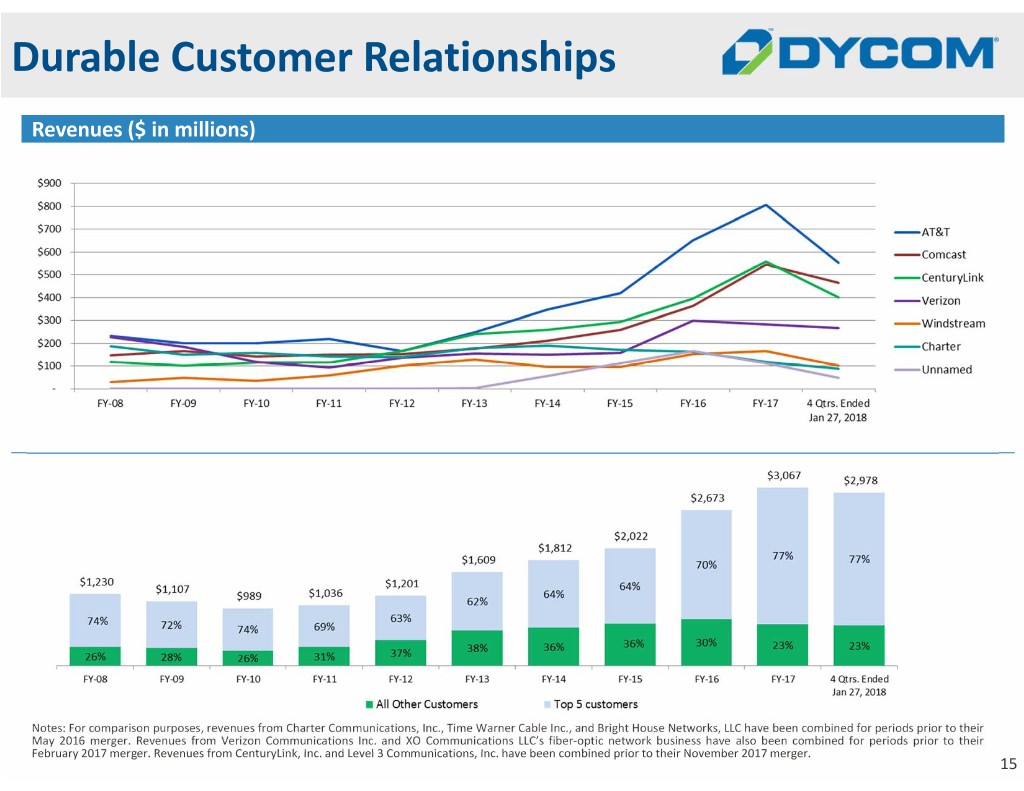
Durable Customer Relationships Revenues ($ in millions) Notes: For comparison purposes, revenues from Charter Communications, Inc., Time Warner Cable Inc., and Bright House Networks, LLC have been combined for periods prior to their May 2016 merger. Revenues from Verizon Communications Inc. and XO Communications LLC’s fiber‐optic network business have also been combined for periods prior to their February 2017 merger. Revenues from CenturyLink, Inc. and Level 3 Communications, Inc. have been combined prior to their November 2017 merger. 15

Anchored by Long‐Term Agreements Revenue by Contract Type for Fiscal Q1‐19 Dycom is party to hundreds of MSA’s and Master Service Agreements other agreements with customers that extend for periods of one or more years Generally multiple agreements maintained with each customer Master Service Agreements (MSA’s) Multi‐year, multi‐million dollar Long‐term arrangements covering thousands of Short‐term contracts individual work orders contracts Generally exclusive requirement Backlog ($ in millions) contracts Agreements can at times be negotiated Majority of contracts are based on units of delivery Backlog at $5.877 billion as of Q1‐19 Our backlog estimates represent amounts under master service agreements and other contractual agreements for services projected to be performed over the terms of contracts. These estimates are generally based on contract terms and assessments regarding the timing of the services to be provided. In the case of master service agreements, backlog is calculated based on the work performed in the preceding twelve month period, when available. When estimating backlog for newly initiated master service agreements and other long and short term contracts, we also consider the anticipated scope of the contract and information received from the customer in the procurement process. A significant majority of our backlog estimates comprise services under master service agreements and other long term contracts. Backlog is not a measure defined by United States generally accepted accounting principles; however, it is a common measurement used in our industry. Our methodology for determining backlog may not be comparable to the methodologies used by others. 16
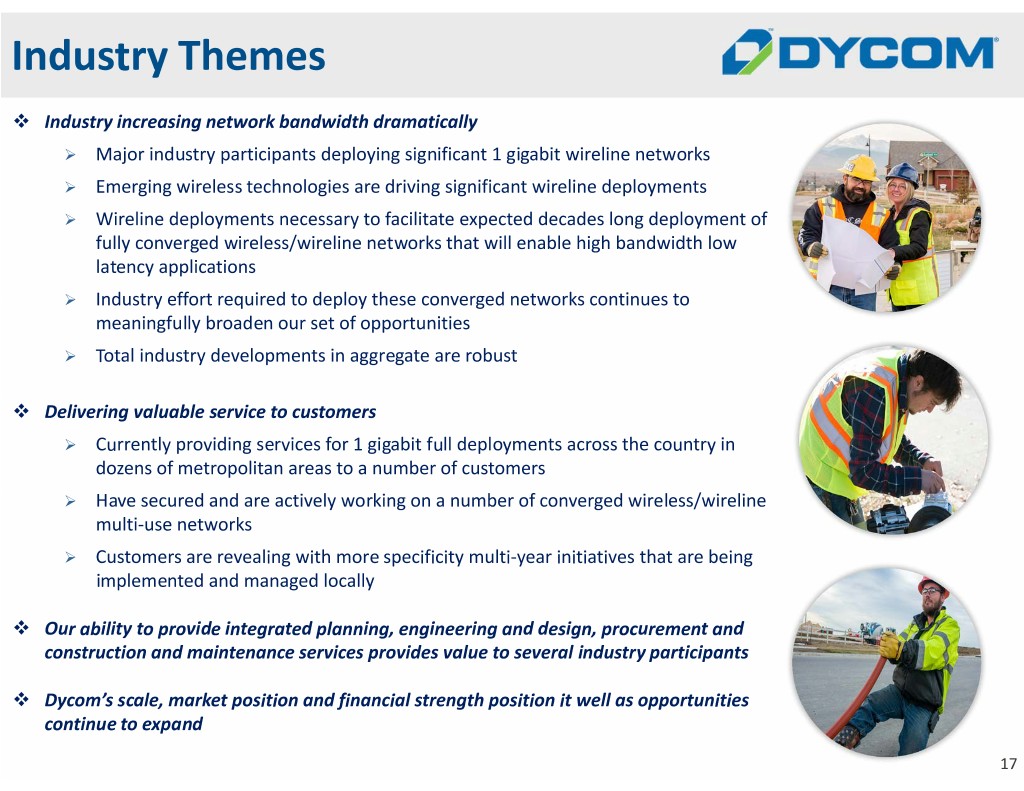
Industry Themes Industry increasing network bandwidth dramatically Major industry participants deploying significant 1 gigabit wireline networks Emerging wireless technologies are driving significant wireline deployments Wireline deployments necessary to facilitate expected decades long deployment of fully converged wireless/wireline networks that will enable high bandwidth low latency applications Industry effort required to deploy these converged networks continues to meaningfully broaden our set of opportunities Total industry developments in aggregate are robust Delivering valuable service to customers Currently providing services for 1 gigabit full deployments across the country in dozens of metropolitan areas to a number of customers Have secured and are actively working on a number of converged wireless/wireline multi‐use networks Customers are revealing with more specificity multi‐year initiatives that are being implemented and managed locally Our ability to provide integrated planning, engineering and design, procurement and construction and maintenance services provides value to several industry participants Dycom’s scale, market position and financial strength position it well as opportunities continue to expand 17

10+ Years of Robust Cash Flow Generation Sources and Uses of Cash ($ in millions) $2,033 $2,033 Strong operating cash flow of $1.405 billion over 10+ years Prudent approach to capital allocation: $472 million invested in share repurchases $597 million invested in business acquisitions $899 million in cap‐ex, net of disposals, or approximately 44% of allocation Fiscal 2008 –4 Quarters Ended Jan. 2018 Robust cash flow generation and prudent capital allocation provide strong foundation for returns Notes: Amounts represent cumulative cash flow for fiscal 2008 – Jan. 2018; See “Regulation G Disclosure” slides as set forth in the Appendix for a summary of amounts. Amounts may not add due to rounding. Other cash flow includes borrowings, other financing and investing activities and beginning cash on hand. 18

Financial Update 19

Financial Overview Strengthening market opportunities despite near‐term revenue declines Contract revenues of $731.4 million in Q1‐19 Non‐GAAP Adjusted EBITDA for the quarter ended April 28, 2018 of $73.7 million, or 10.1% of revenue, compared to $108.2 million, or 13.8% of revenue, for the quarter ended April 29, 2017 Non‐GAAP Adjusted Diluted EPS of $0.65 per share for the quarter ended April 28, 2018, compared to $1.30 per share for the quarter ended April 29, 2017 Solid financial profile Strong balance sheet Robust operating cash flows Sound credit metrics and no near term debt maturities Capital structure designed to produce strong returns As of January 2018, $95.2 million authorized for share repurchases through August 2018 See “Regulation G Disclosure” slides 29‐36 for a reconciliation of GAAP to Non‐GAAP financial measures. 20
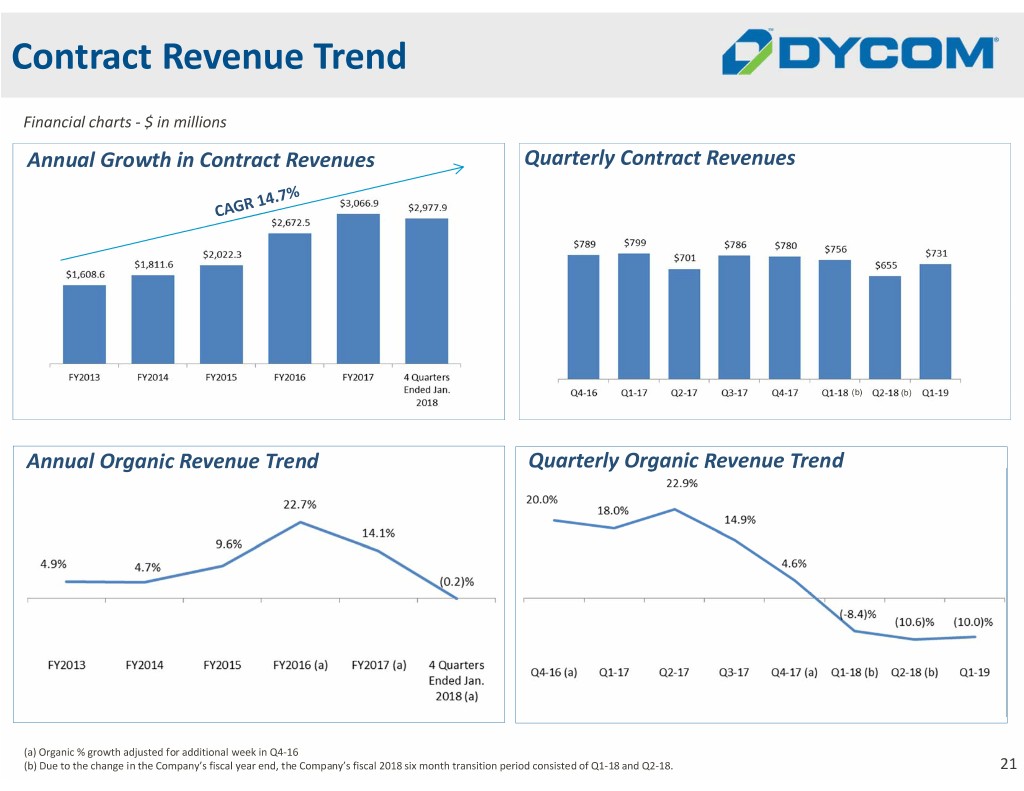
Contract Revenue Trend Financial charts ‐ $ in millions Annual Growth in Contract Revenues Quarterly Contract Revenues (b) (b) Annual Organic Revenue Trend Quarterly Organic Revenue Trend (a) Organic % growth adjusted for additional week in Q4‐16 (b) Due to the change in the Company’s fiscal year end, the Company’s fiscal 2018 six month transition period consisted of Q1‐18 and Q2‐18. 21

Earnings Financial charts ‐ $ in millions, except earnings per share amounts Non‐GAAP Adjusted EBITDA Quarterly Non‐GAAP Adjusted EBITDA (a) (a) Non‐GAAP Adjusted Diluted EPS Quarterly Non‐GAAP Adjusted Diluted EPS (a) (a) (a) Due to the change in the Company’s fiscal year end, the Company’s fiscal 2018 six month transition period consisted of Q1‐18 and Q2‐18. See “Regulation G Disclosure” slides 29‐36 for a reconciliation of GAAP to Non‐GAAP financial measures. 22
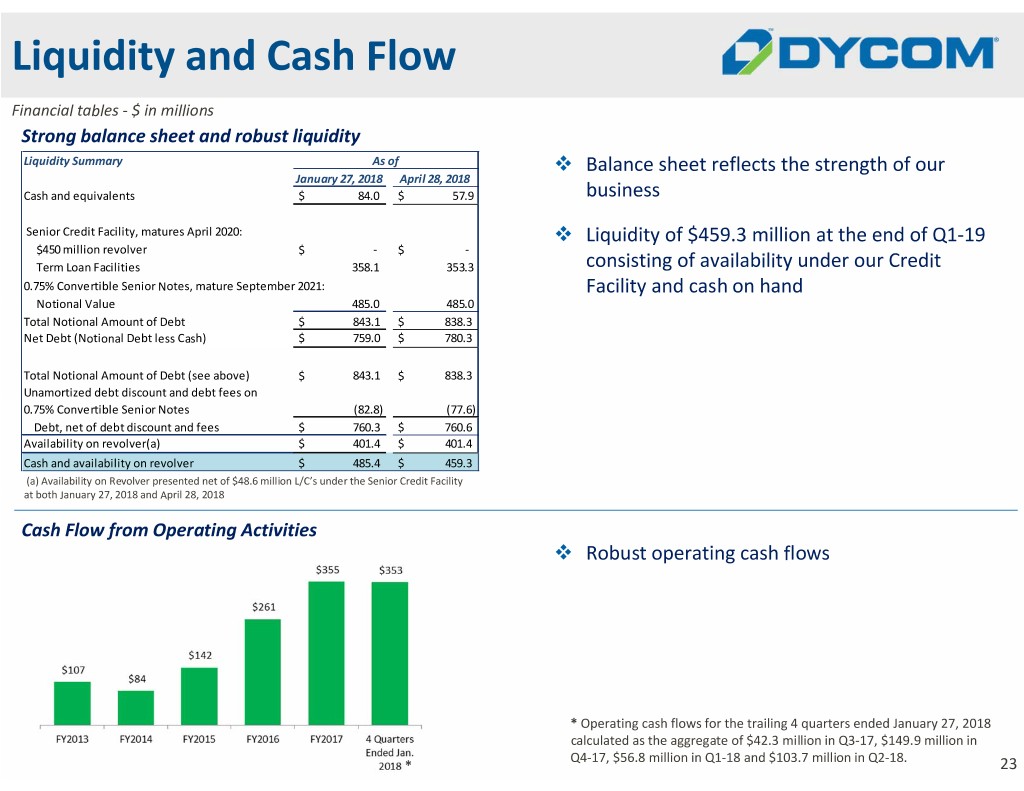
Liquidity and Cash Flow Financial tables ‐ $ in millions Strong balance sheet and robust liquidity Liquidity Summary As of Balance sheet reflects the strength of our January 27, 2018 April 28, 2018 Cash and equivalents $ 84.0 $ 57.9 business Senior Credit Facility, matures April 2020: Liquidity of $459.3 million at the end of Q1‐19 $450 million revolver $ ‐ $ ‐ Term Loan Facilities 358.1 353.3 consisting of availability under our Credit 0.75% Convertible Senior Notes, mature September 2021: Facility and cash on hand Notional Value 485.0 485.0 Total Notional Amount of Debt $ 843.1 $ 838.3 Net Debt (Notional Debt less Cash) $ 759.0 $ 780.3 Total Notional Amount of Debt (see above) $ 843.1 $ 838.3 Unamortized debt discount and debt fees on 0.75% Convertible Senior Notes (82.8) (77.6) Debt, net of debt discount and fees $ 760.3 $ 760.6 Availability on revolver(a) $ 401.4 $ 401.4 Cash and availability on revolver $ 485.4 $ 459.3 (a) Availability on Revolver presented net of $48.6 million L/C’s under the Senior Credit Facility at both January 27, 2018 and April 28, 2018 Cash Flow from Operating Activities Robust operating cash flows * Operating cash flows for the trailing 4 quarters ended January 27, 2018 calculated as the aggregate of $42.3 million in Q3‐17, $149.9 million in Q4‐17, $56.8 million in Q1‐18 and $103.7 million in Q2‐18. * 23
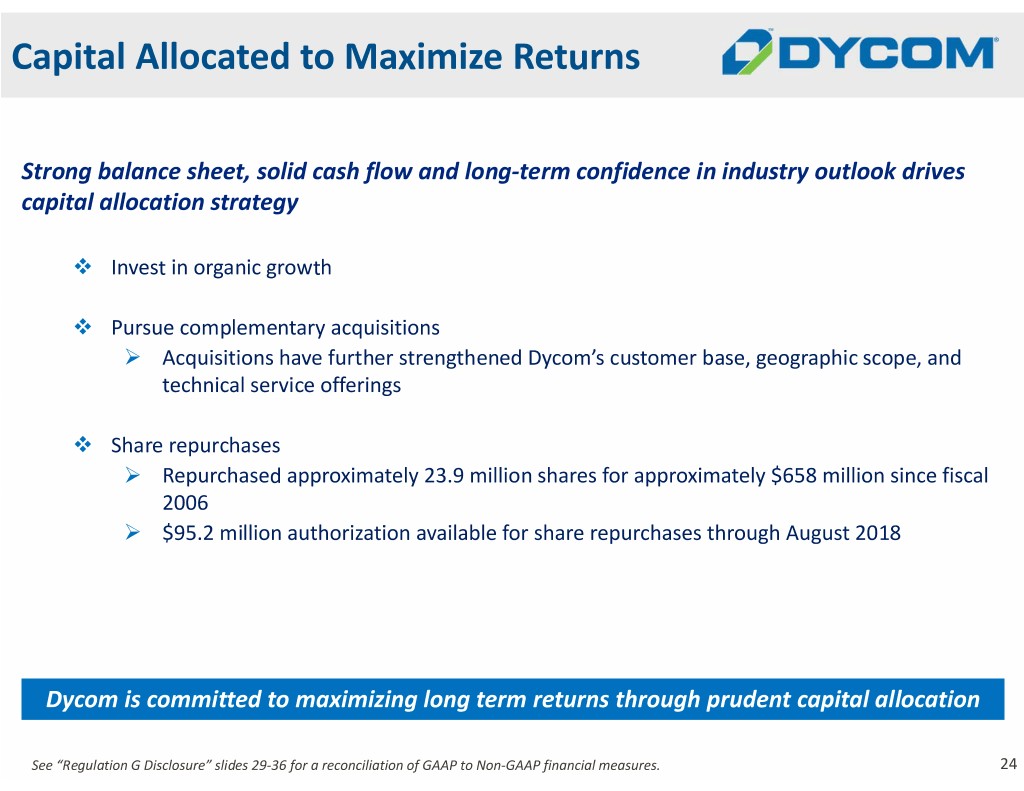
Capital Allocated to Maximize Returns Strong balance sheet, solid cash flow and long‐term confidence in industry outlook drives capital allocation strategy Invest in organic growth Pursue complementary acquisitions Acquisitions have further strengthened Dycom’s customer base, geographic scope, and technical service offerings Share repurchases Repurchased approximately 23.9 million shares for approximately $658 million since fiscal 2006 $95.2 million authorization available for share repurchases through August 2018 Dycom is committed to maximizing long term returns through prudent capital allocation See “Regulation G Disclosure” slides 29‐36 for a reconciliation of GAAP to Non‐GAAP financial measures. 24

Questions and Answers

Selected Information from Q1‐19 Dycom Results Conference Call Materials The following slides 27 & 28 were used on May 22, 2018 in connection with the Company’s conference call for its fiscal 2019 first quarter results and are included for your convenience. Reference is made to slide 2 titled “Forward‐Looking Statements, Non‐GAAP Financial Measures, and Other Information” with respect to these slides. The information and statements contained in slides 27 & 28 that are forward‐looking are based on information that was available at the time the slides were initially prepared and/or management’s good faith belief at that time with respect to future events. Except as required by law, the Company may not update forward‐looking statements even though its situation may change in the future. For a full copy of the conference call materials, including the conference call transcript, see the Company’s Form 8‐Ks filed with the Securities and Exchange Commission on May 22, 2018 and May 23, 2018.
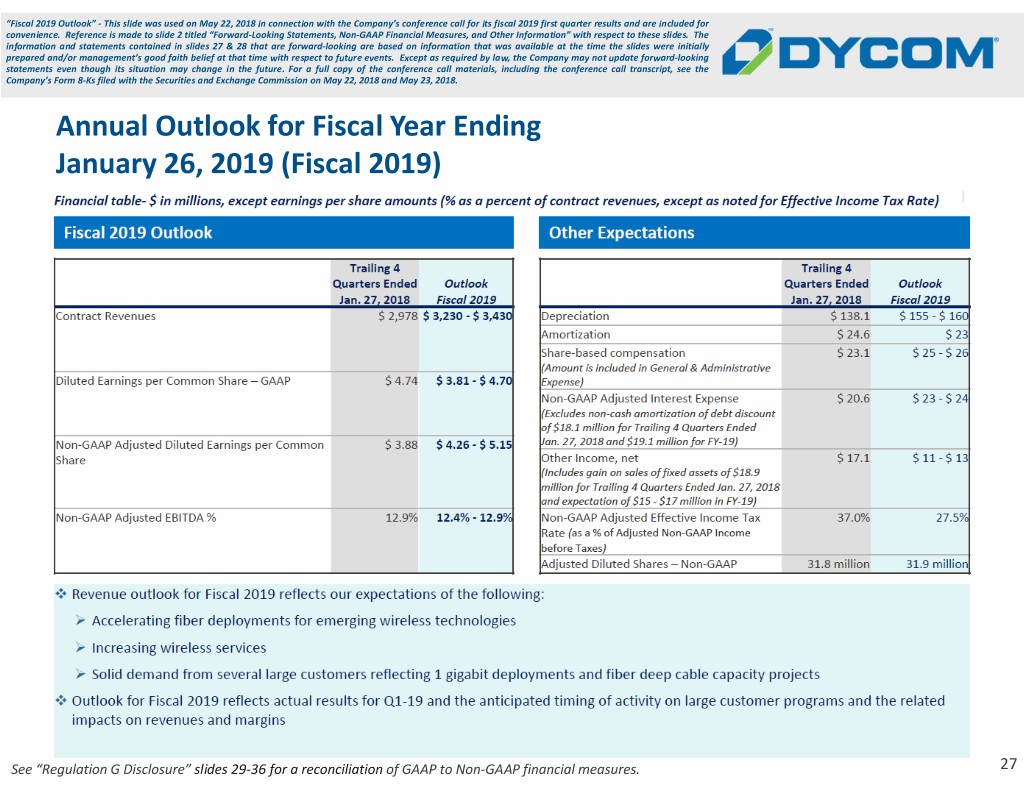
“Fiscal 2019 Outlook” ‐ This slide was used on May 22, 2018 in connection with the Company’s conference call for its fiscal 2019 first quarter results and are included for convenience. Reference is made to slide 2 titled “Forward‐Looking Statements, Non‐GAAP Financial Measures, and Other Information” with respect to these slides. The information and statements contained in slides 27 & 28 that are forward‐looking are based on information that was available at the time the slides were initially prepared and/or management’s good faith belief at that time with respect to future events. Except as required by law, the Company may not update forward‐looking statements even though its situation may change in the future. For a full copy of the conference call materials, including the conference call transcript, see the Company’s Form 8‐Ks filed with the Securities and Exchange Commission on May 22, 2018 and May 23, 2018. Annual Outlook for Fiscal Year Ending January 26, 2019 (Fiscal 2019) See “Regulation G Disclosure” slides 29‐36 for a reconciliation of GAAP to Non‐GAAP financial measures. 27

“Q2‐2019 Outlook” ‐ This slide was used on May 22, 2018 in connection with the Company’s conference call for its fiscal 2019 first quarter results and are included for convenience. Reference is made to slide 2 titled “Forward‐Looking Statements, Non‐GAAP Financial Measures, and Other Information” with respect to these slides. The information and statements contained in slides 27 & 28 that are forward‐looking are based on information that was available at the time the slides were initially prepared and/or management’s good faith belief at that time with respect to future events. Except as required by law, the Company may not update forward‐looking statements even though its situation may change in the future. For a full copy of the conference call materials, including the conference call transcript, see the Company’s Form 8‐Ks filed with the Securities and Exchange Commission on May 22, 2018 and May 23, 2018. Looking Ahead to the Quarter Ending July 28, 2018 (Q2‐2019) See “Regulation G Disclosure” slides 29‐36 for a reconciliation of GAAP to Non‐GAAP financial measures. 28

Appendix: Regulation G Disclosure Explanation of Non‐GAAP Measures The Company reports its financial results in accordance with U.S. generally accepted accounting principles (GAAP). In the Company’s quarterly results releases, trend schedules, conference calls, slide presentations, and webcasts, it may use or discuss Non‐GAAP financial measures, as defined by Regulation G of the Securities and Exchange Commission. The Company believes that the presentation of certain Non‐GAAP financial measures in these materials provides information that is useful to investors because it allows for a more direct comparison of the Company’s performance for the period reported with the Company’s performance in prior periods. The Company cautions that Non‐GAAPfinancialmeasuresshouldbeconsideredinadditionto,but not as a substitute for, the Company’s reported GAAP results. Management defines the Non‐GAAP financial measures used in this trend schedule as follows: • Non‐GAAP Organic Contract Revenues – contract revenues from businesses that are included for the entire period in both the current and prior year periods, excluding contract revenues from storm restoration services, adjusted independently each comparative period for the additional week in the fourth quarter of fiscal 2016, the quarter ended July 30,2016, as a result of the Company’s 52/53 week fiscal year. Non‐GAAP Organic Revenue growth (decline) is calculated as the percentage change in Non‐GAAP Organic Revenues over those of the comparable prior year period. Management believes organic growth (decline) is a helpful measure for comparing the Company’s revenue performance with prior periods. • Non‐GAAP Adjusted EBITDA – net income before interest, taxes, depreciation and amortization, gain on sale of fixed assets, stock‐based compensation expense, loss on debt extinguishment, and certain non‐ recurring items. Management believes Non‐GAAP Adjusted EBITDA is a helpful measure for comparing the Company’s operating performance with prior periods as well as with the performance of other companies with different capital structures or tax rates. • Non‐GAAP Adjusted Net Income – GAAP net income before loss on debt extinguishment, non‐cash amortization of the debt discount and the related tax impact, certain tax impacts resulting from vesting and exercise of share‐based awards, certain tax impacts of Tax Reform, and certain non‐recurring items. • Non‐GAAP Adjusted Diluted Earnings per Common Share and Non‐GAAP Adjusted Diluted Shares –Non‐GAAP Adjusted Net Income divided by Non‐GAAP Adjusted Diluted Shares outstanding. The Company has a note hedge in effect to offset the economic dilution of additional shares from the Notes up to an average quarterly share price of $130.43. The measure of Non‐GAAP Adjusted Diluted Shares used in computing Non‐GAAP Adjusted Diluted Earnings per Common Share excludes dilution from the Notes. Management believes that the calculation of Non‐GAAP Adjusted Diluted Shares to reflect the note hedge is useful to investors because it provides insight into the offsetting economic effect of the hedge against potential conversion of the Notes. Management excludes or adjusts each of the items identified below from Non‐GAAP Adjusted Net Income and Non‐GAAP Adjusted Diluted Earnings per Common Share: • Non‐cash amortization of the debt discount – The Company’s Notes were allocated between debt and equity components. The difference between the principal amount and the carrying amount of the liability component of the Notes represents a debt discount. The debt discount is being amortized over the term of the Notes but does not result in periodic cash interest payments. The Company has excluded the non‐cash amortization of the debt discount from its Non‐GAAP financial measures because it believes it is useful to analyze the component of interest expense for the Notes that will be paid in cash. The exclusion of the non‐cash amortization of the debt discount provides management with a consistent measure for assessing financial results. • Acquisition transaction related costs – The Company incurred costs of approximately $0.7 million in connection with an acquisition during the quarter ended July 30, 2016. The exclusion of the acquisition transaction related costs from the Company’s Non‐GAAP financial measures provides management with a consistent measure for assessing financial results. • Loss on debt extinguishment – The Company incurred a pre‐tax charge of approximately $16.3 million for early extinguishment of debt in connection with the redemption of its 7.125% senior subordinated notes during the first quarter of fiscal 2016. Management believes excluding the loss on debt extinguishment from the Company’s Non‐GAAP financial measures assists investors’ overall understanding of the Company’s current financial performance. The Company believes this type of charge is not indicative of it core operating results. The exclusion of the loss on debt extinguishment from the Company’s Non‐GAAP financial measures provides management with a consistent measure for assessing the current and historical financial results. • Tax impact from Tax Reform – During the quarter ended January 27, 2018, the Company recognized an income tax benefit of approximately $32.2 million resulting from Tax Reform, primarily due to a reduction of net deferred tax liabilities. The Company has excluded this impact because it is a significant change in the U.S. federal corporate tax rate and because the Company believes it is not indicative of the Company's underlying results or ongoing operations. • Tax impact of excess tax benefits as a result of ASU 2016‐09 – ASU 2016‐09, Improvements to Employee Share‐Based Payment Accounting (“ASU 2016‐09”) became effective for the Company July 30, 2017, the first day of the 2018 transition period, and changed the treatment of windfalls (or shortfalls) arising from the vesting and exercise of share‐based awards. Prior to ASU 2016‐09, these amounts were recorded as an adjustment to additional paid‐in capital. With the adoption of ASU 2016‐09, these amounts are now captured in the Company's provision for income taxes. The Company excluded the impact of approximately $6.9 million of excess tax benefits during the quarter ended January 27, 2018 from its provision for income taxes in its Non‐GAAP measures as this amount may vary significantly from period to period and excluding this amount from the Company's Non‐GAAP financial measures provides management with a more consistent measure for assessing financial results. • Tax impact of adjusted results – The tax impact of adjusted results was calculated utilizing a Non‐GAAP effective tax rate which approximates the Company’s effective tax rate used for financial planning for the applicable period. 29

Appendix: Regulation G Disclosure This slide was used on May 22, 2018 in connection with the Company’s conference call for its fiscal 2019 first quarter results and are included for convenience. Reference is made to slide 2 titled “Forward‐Looking Statements, Non‐GAAP Financial Measures, and Other Information” with respect to these slides. The information and statements contained in slides 27 & 28 that are forward‐ looking are based on information that was available at the time the slides were initially prepared and/or management’s good faith belief at that time with respect to future events. Except as required by law, the Company may not update forward‐looking statements even though its situation may change in the future. For a full copy of the conference call materials, including the conference call transcript, see the Company’s Form 8‐Ks filed with the Securities and Exchange Commission on May 22, 2018 and May 23, 2018. Notes: Amounts above may not add due to rounding. Use of Non‐GAAP Financial Measures: The Company reports its financial results in accordance with U.S. generally accepted accounting principles (GAAP). In our quarterly results releases, trend schedules, conference calls, slide presentations, and webcasts, we may use or discuss Non‐GAAP financial measures, as defined by Regulation G of the SEC. See Explanation of Non‐GAAP Measures on slide 29. 30

Appendix: Regulation G Disclosure This slide was used on May 22, 2018 in connection with the Company’s conference call for its fiscal 2019 first quarter results and are included for convenience. Reference is made to slide 2 titled “Forward‐Looking Statements, Non‐GAAP Financial Measures, and Other Information” with respect to these slides. The information and statements contained in slides 27 & 28 that are forward‐ looking are based on information that was available at the time the slides were initially prepared and/or management’s good faith belief at that time with respect to future events. Except as required by law, the Company may not update forward‐looking statements even though its situation may change in the future. For a full copy of the conference call materials, including the conference call transcript, see the Company’s Form 8‐Ks filed with the Securities and Exchange Commission on May 22, 2018 and May 23, 2018. Notes: Amounts above may not add due to rounding. Use of Non‐GAAP Financial Measures: The Company reports its financial results in accordance with U.S. generally accepted accounting principles (GAAP). In our quarterly results releases, trend schedules, conference calls, slide presentations, and webcasts, we may use or discuss Non‐GAAP financial measures, as defined by Regulation G of the SEC. See Explanation of Non‐GAAP Measures on slide 29. 31

Appendix: Regulation G Disclosure Reconciliation of Non‐GAAP Financial Measures to Comparable GAAP Financial Measures Non‐GAAP Organic Contract Revenue Unaudited ($ in millions) Revenue Growth Non‐GAAP Organic (Decline)% Contract Revenues NON‐GAAP ADJUSTMENTS Contract Revenues GAAP % Organic % Revenues from Additional week as a Revenues from storm Quarters Ended: result of our 52/53 acquired businesses restoration week fiscal year (a) Q1‐19 Organic Decline: services April 28, 2018$ 731.4 $ (15.4) $ ‐ $ (14.8) $ 701.1 (7.0)% (10.0)% April 29, 2017$ 786.3 $ (7.1) $ ‐ $ ‐ $ 779.2 Prior Quarters Organic Growth (Decline): January 27, 2018$ 655.1 $ (8.4) $ ‐ $ (19.6) $ 627.1 (6.6)% (10.6)% January 28, 2017$ 701.1 $ ‐ $ ‐ $ ‐ $ 701.1 October 28, 2017$ 756.2 $ (8.6) $ ‐ $ (15.5) $ 732.1 (5.4)% (8.4)% October 29, 2016$ 799.2 $ ‐ $ ‐ $ ‐ $ 799.2 July 29, 2017$ 780.2 $ (19.3) $ ‐ $ ‐ $ 760.9 (1.1)% 4.6% July 30, 2016$ 789.2 $ (5.6) $ (56.0) $ ‐ $ 727.6 April 29, 2017$ 786.3 $ (23.0) $ ‐ $ ‐ $ 763.4 18.3% 14.9% April 23, 2016$ 664.6 $ ‐ $ ‐ $ ‐ $ 664.6 January 28, 2017$ 701.1 $ (13.4) $ ‐ $ ‐ $ 687.7 25.3% 22.9% January 23, 2016$ 559.5 $ ‐ $ ‐ $ ‐ $ 559.5 October 29, 2016$ 799.2 $ (56.6) $ ‐ $ ‐ $ 742.6 21.2% 18.0% October 24, 2015$ 659.3 $ (29.9) $ ‐ $ ‐ $ 629.4 July 30, 2016$ 789.2 $ (44.8) $ (53.2) $ ‐ $ 691.2 36.4% 20.0% July 25, 2015$ 578.5 $ (2.4) $ ‐ $ ‐ $ 576.1 (a) Q4‐16 contained 14 weeks as a result of our 52/53 week fiscal year as compared to 13 weeks in all other quarterly periods presented herein. The Q4‐16 Non‐GAAP adjustment is calculated independently for each comparative period as (i) contract revenues less, (ii) contract revenues from acquired businesses in each applicable period, (iii) divided by 14 weeks. Notes: Amounts above may not add due to rounding. Use of Non‐GAAP Financial Measures: The Company reports its financial results in accordance with U.S. generally accepted accounting principles (GAAP). In our quarterly results releases, trend schedules, conference calls, slide presentations, and webcasts, we may use or discuss Non‐GAAP financial measures, as defined by Regulation G of the SEC. See Explanation of Non‐GAAP Measures on slide 29. 32

Appendix: Regulation G Disclosure Contract Revenues and Organic Growth ‐ Reconciliation of GAAP to Non‐GAAP Measures ($ in millions) The table below reconciles GAAP revenue growth to Non‐GAAP organic revenue growth NON‐GAAP ADJUSTMENTS Revenue Growth (Decline)% Additional week Revenues from Revenues from as a result of our Non‐GAAP ‐ GAAP Contract acquired storm restoration 52/53 week fiscal Organic Contract Non‐GAAP ‐ Revenues businesses services year (a) Revenues GAAP % Organic % 4 Quarters Ended January 27, 2018$ 2,977.9 $ (87.3) $ (35.1) $ ‐ $ 2,855.5 0.8% (0.2)% 4 Quarters Ended January 28, 2017 (b)$ 2,954.2 $ (37.3) $ ‐ $ (56.0) $ 2,860.9 Fiscal 2017$ 3,066.9 $ (214.9) $ ‐ $ ‐ $ 2,852.0 14.8% 14.1% Fiscal 2016$ 2,672.5 $ (119.8) $ ‐ $ (53.5) $ 2,499.2 Fiscal 2016$ 2,672.5 $ (159.0) $ ‐ $ (52.9) $ 2,460.7 32.2% 22.7% Fiscal 2015$ 2,022.3 $ (17.7) $ ‐ $ ‐ $ 2,004.7 Fiscal 2015$ 2,022.3 $ (40.4) $ ‐ $ ‐ $ 1,982.0 11.6% 9.6% Fiscal 2014$ 1,811.6 $ (2.8) $ ‐ $ ‐ $ 1,808.8 Fiscal 2014$ 1,811.6 $ (499.3) $ ‐ $ ‐ $ 1,312.3 12.6% 4.7% Fiscal 2013$ 1,608.6 $ (337.9) $ (16.7) $ ‐ $ 1,254.0 Fiscal 2013$ 1,608.6 $ (337.9) $ (16.7) $ ‐ $ 1,254.0 33.9% 4.9% Fiscal 2012$ 1,201.1 $ ‐ $ (6.0) $ ‐ $ 1,195.1 (a) Non‐GAAP adjustments in FY 2016 reflect adjustments in Q4‐16 resulting from the Company’s 52/53 week fiscal year. The Q4‐16 Non‐GAAP adjustment is calculated independently for each comparative period as (i) contract revenues less, (ii) revenues from acquired businesses in each applicable period, (iii) divided by 14 weeks. (b) Revenue for the 4 Quarters Ended January 28, 2017 is calculated as the aggregate of $664.6 million in Q3‐16, $789.2 million in Q4‐16, $799.2 million in Q1‐17, and $701.1 million in Q2‐17. Notes: Amounts above may not add due to rounding. Use of Non‐GAAP Financial Measures: The Company reports its financial results in accordance with U.S. generally accepted accounting principles (GAAP). In our quarterly results releases, trend schedules, conference calls, slide presentations, and webcasts, we may use or discuss Non‐GAAP financial measures, as defined by Regulation G of the SEC. See Explanation of Non‐GAAP Measures on slide 29. 33

Appendix: Regulation G Disclosure Reconciliation of Non‐GAAP Financial Measures to Comparable GAAP Financial Measures Calculation of Cumulative Cash Flows Fiscal 2008 through Fiscal 2018 Unaudited ($ in millions) Total Amount Net Cash Provided Capital Expenditures, Cash Paid for Provided by Other by Operating Net of Proceeds from Acquisitions, net Repurchases of Borrowings and Other Other Investing Financing and Activities Asset Sales of cash qacuired Common Stock Financing Activities 1 Activities 2 Investing Activities Six months ended Jan. 2018$ 160.5 $ (76.0) $ ‐ $ (16.9) $ (21.5) $ (0.7) $ (22.2) FY‐17 256.4 (185.2) (24.2) (62.9) 20.4 0.3 20.7 FY‐16 261.5 (175.5) (157.2) (170.0) 254.1 (0.5) 253.6 FY‐15 141.9 (93.6) (31.9) (87.1) 75.9 (4.5) 71.4 FY‐14 84.2 (73.7) (17.1) (10.0) 19.0 (0.3) 18.7 FY‐13 106.7 (58.8) (330.3) (15.2) 263.5 0.1 263.6 FY‐12 65.1 (52.8) ‐ (13.0) 7.6 0.9 8.5 FY‐11 43.9 (49.2) (36.5) (64.5) 47.5 0.2 47.7 FY‐10 54.1 (46.6) ‐ (4.5) (4.4) ‐ (4.4) FY‐09 126.6 (25.3) ‐ (2.9) (15.7) (0.1) (15.8) FY‐08 104.3 (62.3) 0.5 (25.2) (13.8) (0.3) (14.1) Cumulative$ 1,405.3 $ (899.1) $ (596.7) $ (472.2) $ 632.6 $ (4.9) $ 627.7 Cash at January 27, 2018 $ 84.0 Cash at July 28, 2007 18.8 Net Increase in Cash $ 65.2 Notes: Amounts may not add due to rounding. 1 Other financing activities represents net cash provided by (used in) financing activities less repurchases of common stock. 2 Other investing activities represents net cash provided by (used in) investing activities less capital expenditure, net of proceeds from asset sales and less cash paid for acquisitions, net of cash acquired. 34

Appendix: Regulation G Disclosure Reconciliation of Non‐GAAP Financial Measures to Comparable GAAP Financial Measures Non‐GAAP Adjusted Net Income, Non‐GAAP Adjusted Diluted EPS, and Non‐GAAP Adjusted Interest Expense Unaudited ($ in 000's, except per share amounts) (a) During the quarter ended January 27, 2018, the Company recognized an income tax benefit of approximately $32.2 million resulting from the Tax Cuts and Jobs Act of 2017 (“Tax Reform”), primarily due to the re‐measurement of the Company’s net deferred tax liabilities at a lower U.S. federal corporate income tax rate. (b) During the quarter ended January 27, 2018, the Company recognized an income tax benefit of approximately $6.9 million for the tax effects of the vesting and exercise of share‐based awards. (c) The Company has a note hedge in effect to offset the economic dilution of additional shares from the Notes up to an average quarterly share price of $130.43 per share. Non‐GAAP Adjusted Diluted Shares excludes the GAAP dilutive effect of the Notes. Notes: Amounts above may not add due to rounding. Use of Non‐GAAP Financial Measures: The Company reports its financial results in accordance with U.S. generally accepted accounting principles (GAAP). In our quarterly results releases, trend schedules, conference calls, slide presentations, and webcasts, we may use or discuss Non‐GAAP financial measures, as defined by Regulation G of the SEC. See Explanation of Non‐GAAP Measures on slide 29. 35

Appendix: Regulation G Disclosure Reconciliation of Non‐GAAP Financial Measures to Comparable GAAP Financial Measures Non‐GAAP Adjusted EBITDA Unaudited ($ in 000's, except per share amounts) Reconciliation of Net Income to Non‐GAAP Adjusted EBITDA 4 Qtrs. Ended Fiscal 2013 Fiscal 2014 Fiscal 2015 Q1‐16 Q2‐16 Q3‐16 Q4‐16 Fiscal 2016 Q1‐17 Q2‐17 Q3‐17 Q4‐17 Fiscal 2017 Q1‐18 Q2‐18 Q1‐19 Jan 27, 2018 Net income $ 35.2 $ 40.0 $ 84.3 $ 30.8 $ 15.5 $ 33.1 $ 49.4 $ 128.7 $ 51.1 $ 23.7 $ 38.8 $ 43.7 $ 157.2 $ 28.8 $ 40.1 $ 151.3 $ 17.2 Provision (benefit) for income taxes 23.0 26.3 51.3 18.6 10.0 19.4 29.6 77.6 30.3 14.0 22.7 26.1 93.2 15.6 (37.9) 26.6 6.5 Interest expense, net 23.3 26.8 27.0 9.1 7.9 8.0 9.7 34.7 9.1 9.2 9.4 9.7 37.4 9.7 9.9 38.7 10.2 Depreciation 64.8 74.5 79.3 22.7 25.2 27.0 30.6 105.5 28.4 29.6 31.2 34.0 123.1 36.4 36.6 138.1 37.7 Amortization 20.7 18.3 16.7 4.8 4.7 4.5 5.4 19.4 6.2 6.1 6.2 6.3 24.8 6.3 5.8 24.6 5.7 EBITDA 167.0 185.9 258.7 86.0 63.2 92.0 124.7 366.0 125.0 82.6 108.3 119.8 435.7 96.7 54.4 379.3 77.2 Gain on sale of fixed assets (4.7) (10.7) (7.1) (1.1) (1.0) (4.1) (3.6) (9.8) (1.4) (1.7) (5.0) (6.6) (14.9) (6.5) (0.7) (18.9) (8.4) Stock‐based compensation expense 9.9 12.6 13.9 4.5 4.2 3.9 4.2 16.9 5.7 5.3 4.9 4.9 20.8 7.3 5.9 23.1 4.8 Loss on debt extinguishment ‐ ‐ ‐ 16.3 ‐ ‐ ‐ 16.3 ‐ ‐ ‐ ‐ ‐ ‐ ‐ ‐ ‐ Acquisition related costs 6.8 ‐ ‐ ‐ ‐ ‐ 0.7 0.7 ‐ ‐ ‐ ‐ ‐ ‐ ‐ ‐ ‐ Charges for settlement of wage and hour litigation 0.5 0.6 ‐ ‐ ‐ ‐ ‐ ‐ ‐ ‐ ‐ ‐ ‐ ‐ ‐ ‐ ‐ Non‐GAAP Adjusted EBITDA$ 179.8 $ 188.4 $ 265.5 $ 105.7 $ 66.4 $ 91.9 $ 126.0 $ 390.0 $ 129.2 $ 86.2 $ 108.2 $ 118.0 $ 441.6 $ 97.6 $ 59.6 $ 383.5 $ 73.6 Reconciliation of Non‐GAAP Adjusted EBITDA (from above) as a % of Revenue 4 Qtrs. Ended Fiscal 2013 Fiscal 2014 Fiscal 2015 Q1‐16 Q2‐16 Q3‐16 Q4‐16 Fiscal 2016 Q1‐17 Q2‐17 Q3‐17 Q4‐17 Fiscal 2017 Q1‐18 Q2‐18 Q1‐19 Jan 27, 2018 Total contract revenues$ 1,608.6 $ 1,811.6 $ 2,022.3 $ 659.3 $ 559.5 $ 664.6 $ 789.2 $ 2,672.5 $ 799.2 $ 701.1 $ 786.3 $ 780.2 $ 3,066.9 $ 756.2 $ 655.1 $ 2,977.9 $ 731.4 EBITDA as a percentage of contract revenues 10.4% 10.3% 12.8% 13.1% 11.3% 13.8% 15.8% 13.7% 15.6% 11.8% 13.8% 15.4% 14.2% 12.8% 8.3% 12.7% 10.6% Non‐GAAP Adjusted EBITDA as a % of contract revenues 11.2% 10.4% 13.1% 16.0% 11.9% 13.8% 16.0% 14.6% 16.2% 12.3% 13.8% 15.1% 14.4% 12.9% 9.1% 12.9% 10.1% Notes: Amounts above may not add due to rounding. Use of Non‐GAAP Financial Measures: The Company reports its financial results in accordance with U.S. generally accepted accounting principles (GAAP). In our quarterly results releases, trend schedules, conference calls, slide presentations, and webcasts, we may use or discuss Non‐GAAP financial measures, as defined by Regulation G of the SEC. See Explanation of Non‐GAAP Measures on slide 29. 36

Investor Presentation May & June 2018
